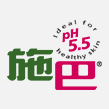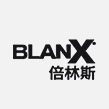Nielsen: The trend of importation, high-end and branding of mother and baby fast consumables is highlighted
Under the background of consumption escalation and downward flow, new consumption concepts give birth to new market opportunities, and the focus of enterprise channel layout is constantly adjusting. In addition, with the increase of the proportion of two-child families and the change of consumption preferences of new mothers and infants, there are many new trends and opportunities in the mother-infant market. How should mother-infant enterprises perceive changes and seize opportunities? At the "New Family Growth, China's Maternal and Child Entrepreneur Leaders Summit 2018" sponsored by Mother and Child Industry Watch, Nielsen released "New Trends of Chinese Infant and Child Fast Consumption Products", sharing the latest insights of consumers of mother and child channel categories and the future development trend of mother and child fast Consumption products, providing a reference for the development of mother and child enterprises.
First, the economy is running steadily and slowly, and household consumption expenditure is increasing.
According to Nielsen's macro-consumption trend, China's consumption trend index is still in a relatively high position in the world, reaching 112 in the last third quarter, but it has declined compared with the first quarter of 2018. China's GDP growth is still stable at 6.5% to 6.9%, and the macro consumer market is relatively stable as a whole.
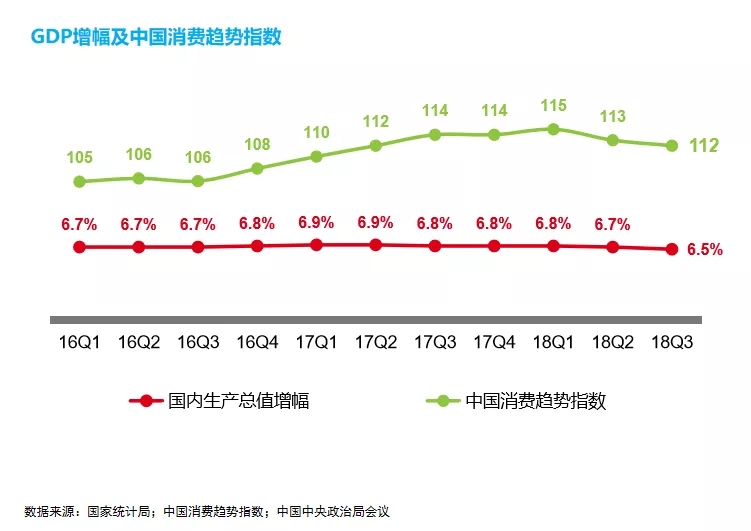
In addition, the state has also introduced the "six stability" policy, including: 1. Employment, control of urban unemployment rate below 4%; 2. Further standardization of the financial regulatory system; 3. further promotion of investment and foreign investment; 4. Foreign trade, the total import and export volume in the third quarter of 2018 increased by 13.8% year on year, which is a bright spot from the macroeconomic point of view; 5. Finally, expectations, continue. Strengthening supply-side reform will play a certain role in expanding domestic demand.
There are three main components of consumption trend index: first, employment expectation (job security and long-term employment vision); second, personal economic situation (personal employment income and income from financial management); and last, consumption intention. As can be seen from the chart, almost all three major indicators are at high levels in the first quarter of the consumer trend index in 2018, but in the past two and three quarters, employment expectations and consumer willingness have declined, while the personal economic situation is in a flat state.

In fact, the personal economic situation has benefited from the reform of individual tax and maintained basic stability. Since January 2019, a new tax reform has been implemented. The increase of the starting point, including the expansion of the gap between low tax rates, has a very good effect on personal income. The special deduction of the Sixth National Congress has played a positive role in the growth of personal and family expenditure.
In the current complex market situation, Nielsen has done a quarterly survey of consumers in order to understand consumers more objectively. From the research results, it can be seen that the proportion of household consumption expenditure in increasing and maintaining the same is still in a relatively high position, and there is no obvious trend of decreasing expenditure. Similarly, in terms of the ratio of increasing and reducing household expenditure, in the first, second and third quarters of the past, the proportion of increasing is higher than decreasing. At the macro level, it is still releasing positive signals.
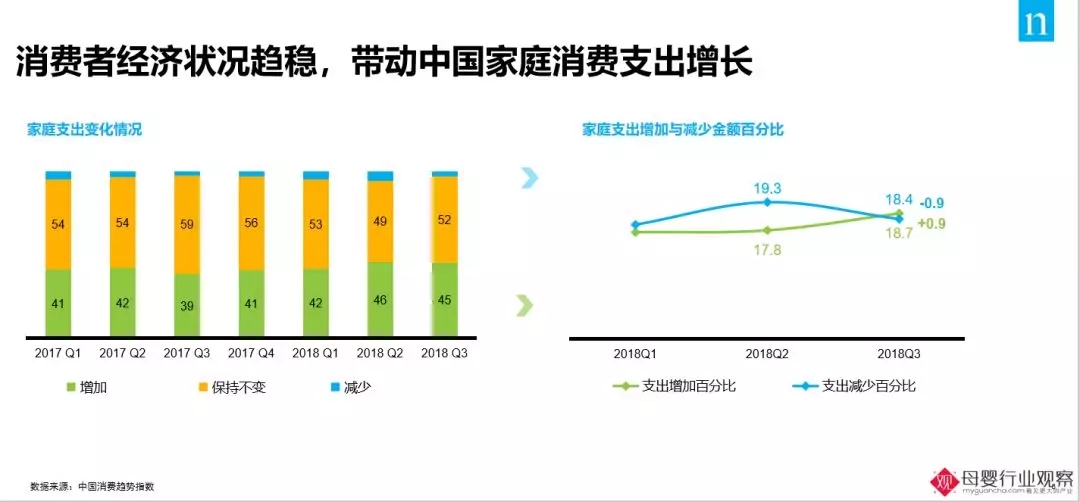
Second,Channels, Categories and Shoppers'Insights for Mothers and Infants in 2018
1. Dynamic Tracking of Mother-Child Channel
1) Double-digit growth of mother-to-child channels and significant growth of mother-to-child Market
From the point of view of mother-to-child channel, Nielsen cooperates with many mother-to-child channels, such as online and offline retailers for market data, which mostly reflects terminal data. Chinese traditional retail channels, offline mainly include supermarkets, supermarkets (large supermarkets and small supermarkets), convenience stores, and other channels, such as mother-to-child channels and cosmetics channels. From the figure, we can see that in the past two years, the growth of traditional supermarket channels is very weak, the cosmetics franchise stores and mother-to-child channels still maintain very high double-digit growth, which is an important reason to promote the growth of fast consumer goods online and offline channels, especially mother-to-child channels. Compared with 2017, the growth rate is still expanding to 15% by November 2018.
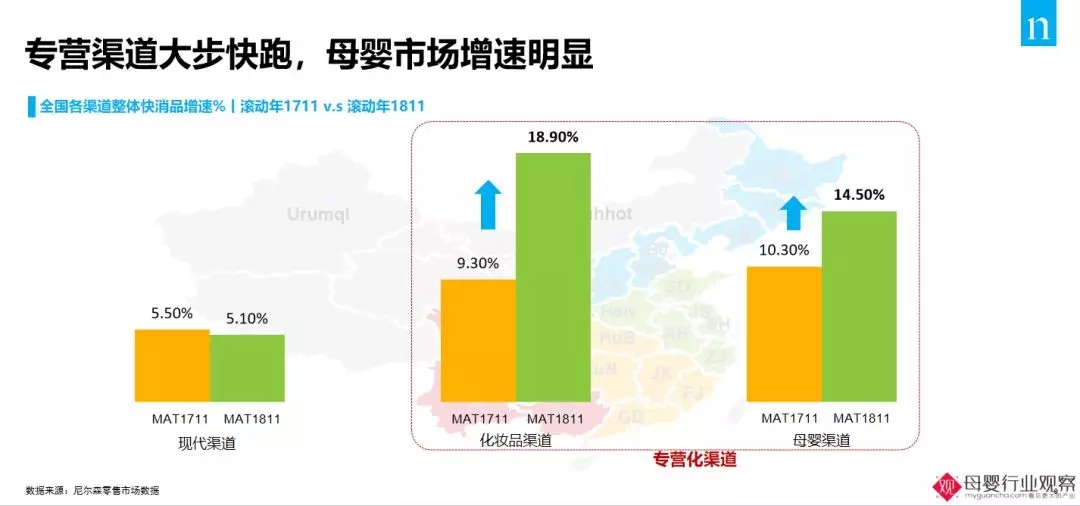
2) Off-line mother-to-child channel is still the main battlefield, and its share continues to expand.
Looking at the whole channel of mother and infant, the three colors represent e-commerce, mother and infant channels and Shangchao channels respectively. From the figure, we can see that compared with the past two years, the off-line channel of mother and infant is still the most important battlefield for the sale of the whole category of mother and infant consumer goods, accounting for about 50% of the share, which continues to expand and has increased by 15% in the past year. At the same time, online e-commerce continues to make great strides, with the total category of mother-to-child majors increasing by 23% in the past year. These two channels have basically promoted the growth of the retail market of mother-to-child fast consumables as a whole. Nielsen divides the whole year into 12 months. According to the monthly data, the off-line mother-to-child channel is also the main part of the overall mother-to-child fast consumption channel. However, e-commerce festivals such as Shuangxi will squeeze off-line mother-to-child channel and business channel to a certain extent, but in traditional festivals such as the Spring Festival, off-line mother-to-child channel is still the main sales force.
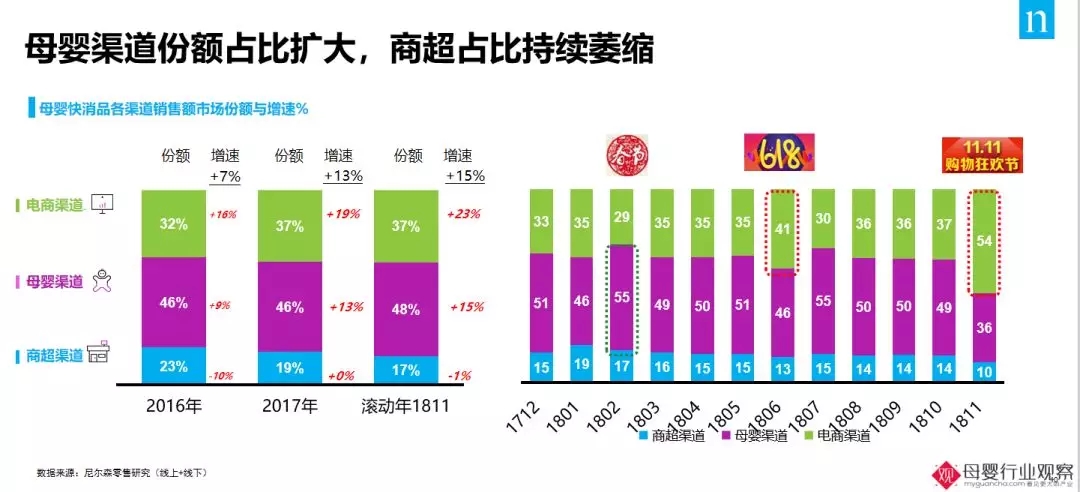
3) The growth rate of maternal and infant categories slowed down in 2018
In the whole channel data, the overall fast consumer goods in the first, second and third quarters of 2016 are at a very small growth stage, but the overall fast consumer goods in 2018 are at a very good growth rate, the growth rate of the whole channel is about 14%. Then in the maternal and infant category, we can see that the third quarter of 2016 to the first quarter of 2018 is in blowout period, whether online or offline, basically restored to a high double-digit growth, online more than 20%. But in recent quarters, especially in the third and fourth quarters, the growth is expected to slow down somewhat. In terms of maternal and infant products, infant food is still the head food, which has increased by 16% in the past year, which is the main factor to promote the growth of maternal and infant fast-food products.

2. Development of Key Categories for Mothers and Infants
1) Category channel differentiation: mother-child channel dominates, e-commerce growth is strong
Then cut down some key categories, there are six main categories: infant milk powder, infant food, infant diapers, bottles, nipples, suckers. The three channels of these six categories account for respectively. Infant milk powder, food and nipples are the higher proportion of the channels of mother and infant, which can basically reach 50% to 60%, which is the most important channel. Online is also continuing to accelerate, milk powder, baby diapers, pacifier line growth is higher than the entire maternal and child channels. But the traditional channel of Shang Chao is basically in a shrinking state.
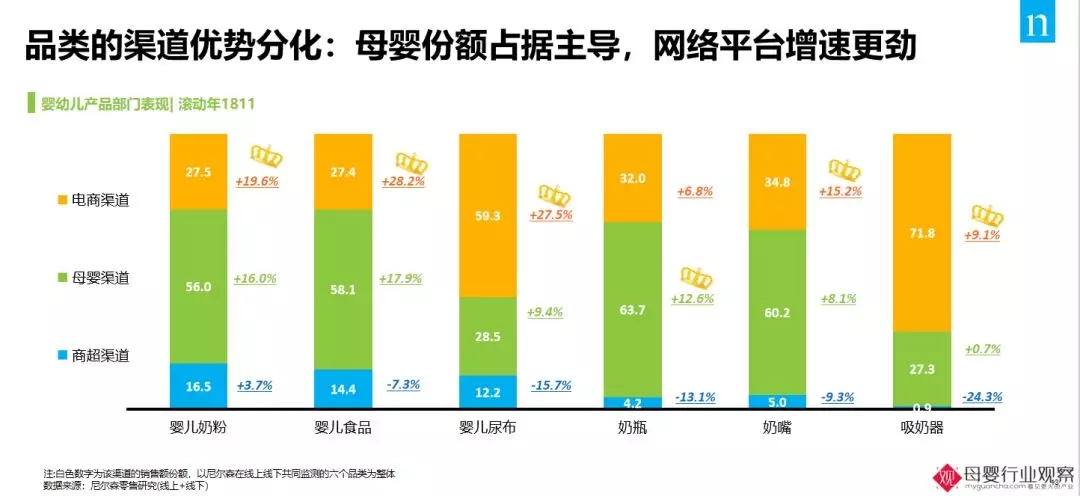
For growth, we must analyze the reasons behind the growth. In a relatively scientific and quantitative way, there are four main reasons for the growth: first, quantity, whether more products are put out, and consumers eventually form a purchase; second, price, which can promote the growth of overall sales from the perspective of price increase; third, consumption upgrading, which is the most important proposition; The latter is new products, a large number of new products from the premium way to the market, to promote the growth of the overall category.
2) Consumption upgrading and the main driving force for the growth of new products mother-to-child Market
Compared with the past two years, the five major categories can hardly see the volume promoting growth, the sales part has basically not contributed, and it is the angle of lowering the overall sales. For example, the amount of infant milk powder in the head in 2018 basically did not increase, but more through consumption upgrading and new products, the trend is also shown in diapers, bottles, baby food and other categories.
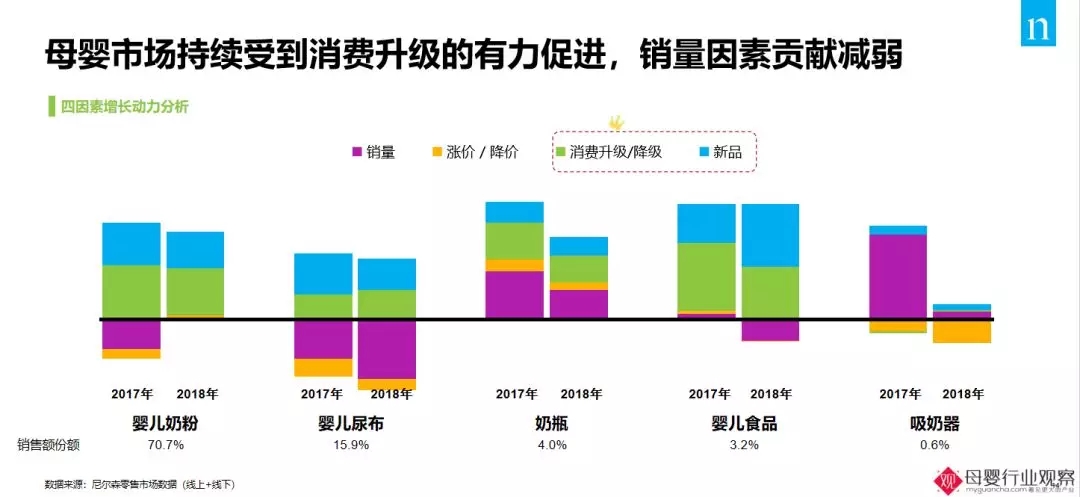
3) The trend of subdividing categories: organic milk powder increased by 50%.
It is worth noting that consumption upgrading and new products are promoting the growth of the whole maternal and infant category. For a simple example, according to statistics, the growth rate of organic milk powder is much higher than that of other categories, reaching nearly 50%. It is an important sub-category of the whole milk powder category, and the organic baby food has also promoted the growth of the maternal and infant market in the past few years.

4) Consumers pay more and more attention to quality and internationalization
Speaking of consumption upgrading, Nielsen mainly analyzed the mainstream brands. The top five diaper brands are relatively centralized categories, all of which are foreign-funded brands. The contribution rate is nearly 40%, which is a highly centralized category. In terms of bottles, besides the traditional glass bottle materials, consumers are more concerned about safety, health and high quality products. In the past year, the growth rate of PPSU bottles, including silicone bottles, is very high, exceeding 30%, which promotes the growth of bottle sales. PPSU is resistant to falling and heating. It is not easy to produce chemical toxins in the process of heating and disinfection. Consumers have a great role in promoting this kind of products.
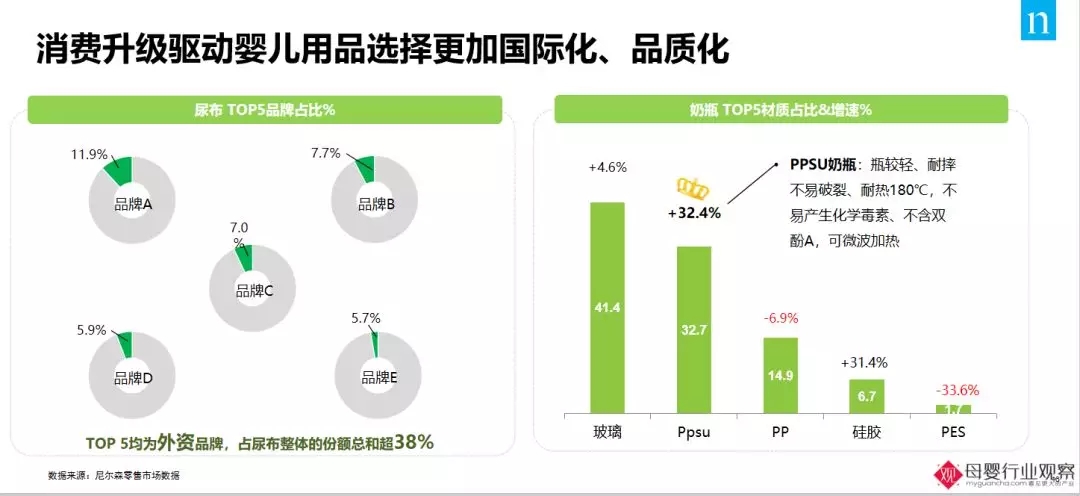
3. Observation on Shoppers of Maternal and Infant Fast Consumptions
1) Nursing stores have become second-child families with good consumption minds, and channels have accelerated integration.
No matter how the market changes, research consumers, users and members will always be the core. Comparing the data of maternal and infant consumers in these two years, the number of second births is increasing, and the proportion of second-born families is increasing. Comparing one-child families with two-child families, where do they prefer to go shopping? Why? Through insights over the past year, Nielsen found that in addition to traditional mother-to-child channels, business supermarkets and online channels, families of two children prefer to buy mother-to-child products through personal care channels. Channels are accelerating integration, not only online and offline integration, but also the integration of different types of offline channels.
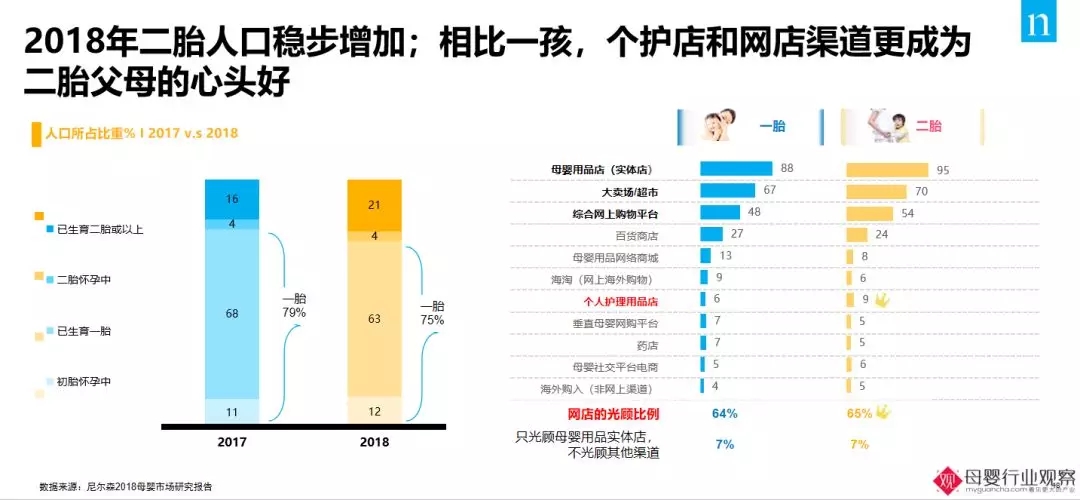
2) Accelerated increase of online channel permeability
It is worth mentioning that the impact of online on offline still exists. Over the past few years, online penetration has accelerated. Whether it has been to online shopping platforms, including the penetration of regular purchases within a month, the top three categories on the Internet are diapers, children's clothes and toys. At the same time, feeding supplies are more important categories of Online channels.
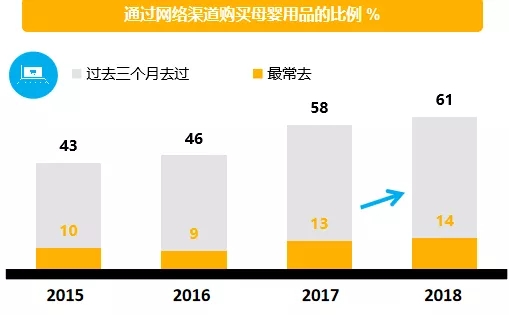
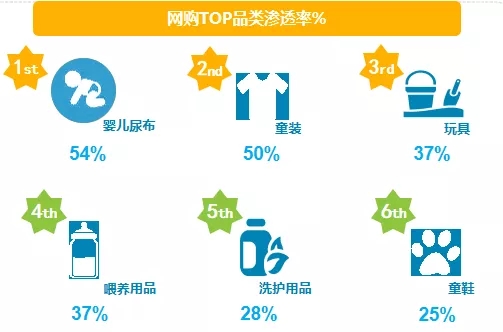
3) One-stop service and experience are becoming more and more important for offline channels
Although we have been talking about online and offline integration, many problems have arisen in the process of integration. From the perspective of consumers, what factors make consumers choose to buy online or offline? What is the difference? Through the comparison of two years'research data, Nielsen found that the reasons for consumers to buy mother and child products online and offline are changeable. The online comparative advantages lie in immediate ordering, saving time, convenience, urban short-distribution logistics, timely door-to-door delivery, commodity comparison; while offline is mainly the complete category, the real price and more brands can choose, among other things. In addition, the offline channel has highlighted two reasons in the past year. The first is whether the offline mother-and-child stores can meet the one-stop service needs. The second is whether they have experience, such as the area where babies play. Choosing offline channels is more about experience and occupying consumers'minds in a warm way.
3. New Trends of Maternal and Infant Fast Consumer Products: Importing, High-end and Branding
The trend of the future development of mother-to-child fast consumables is still to import, high-end and brand.
From the point of view of importation, we mainly analyze several major weight categories. Milk powder and diapers are the most important weight categories of mother and infant fast consumption products. In the category of milk powder, imported milk powder still accounts for 60% of the offline channels in the past year, the growth rate is as high as 16%, and continues to erode the share of domestic brands. From the perspective of baby diapers, imported brands are still rising, while domestic brands are slightly lower. Drop. Other categories with slightly smaller weights, such as bottles, nipples and suckers, account for a relatively high domestic share of the battlefield and have a good growth. Analyzing the proportion of channels in the whole milk powder category, online channel imports accounted for 74% and offline channel 60%. The growth rate reached 19% and 16% respectively, and the imports increased at a high speed.
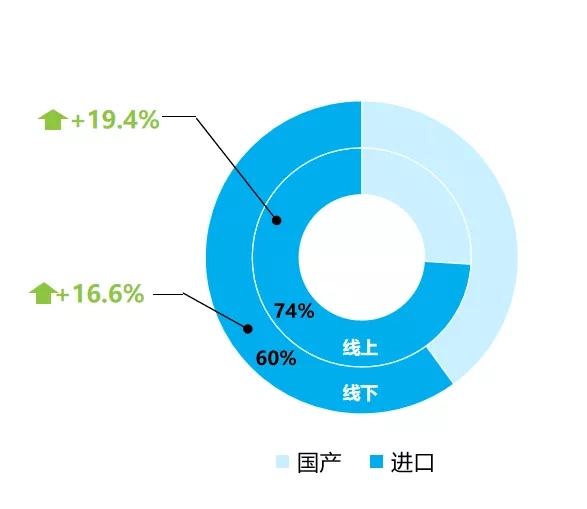
From the high-end point of view, the analysis of milk powder price segment shows that the growth rate of ultra-high-end milk powder reaches 60%, which will further aggravate the pattern of the whole milk powder category. This point is also very obvious in the diaper category, the price of more than 160 yuan, which is 1.6 times higher than the market price of high-end baby diapers increased to 30%.
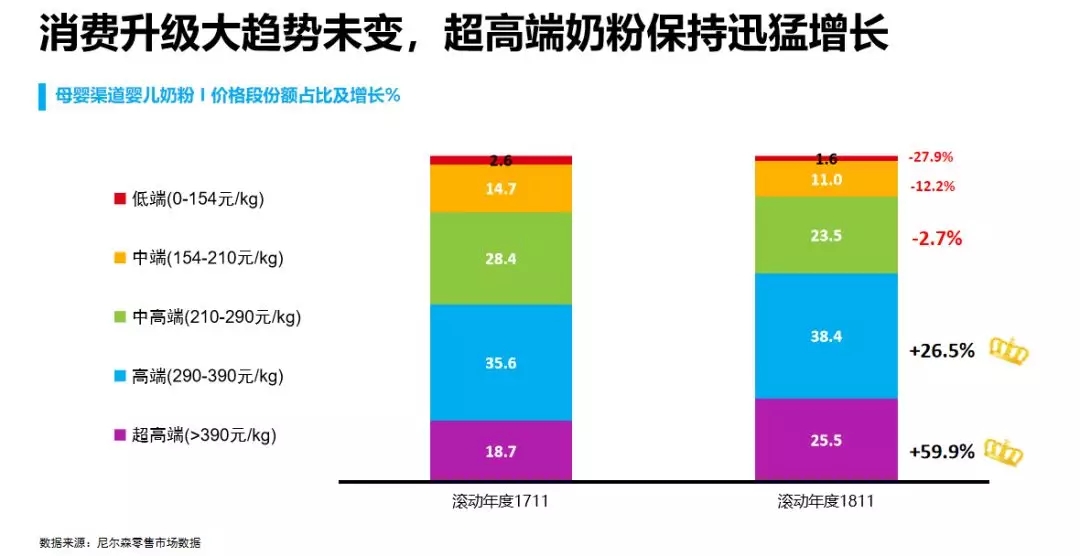
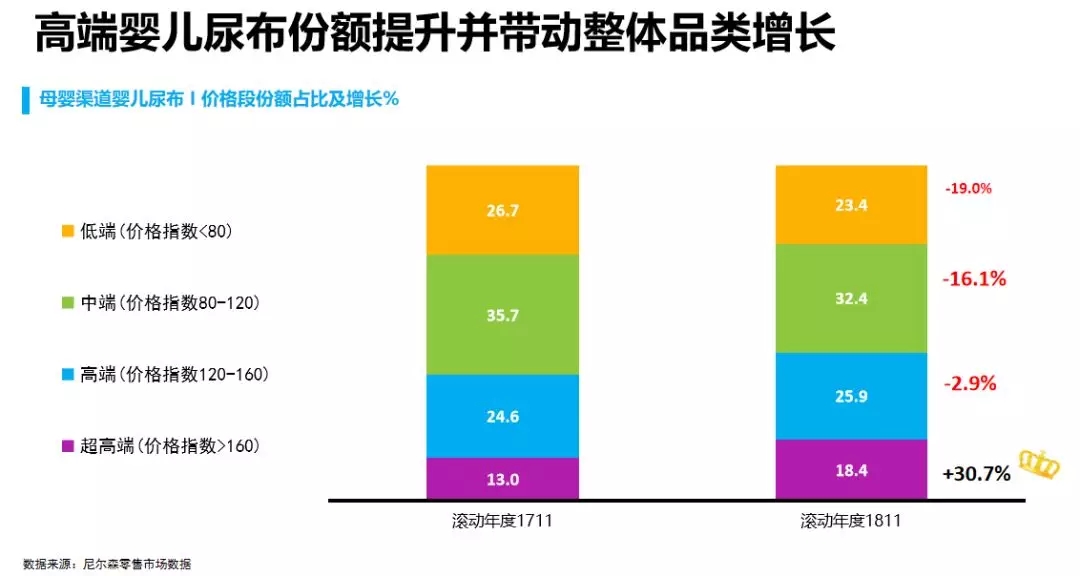
From the perspective of branding, milk powder and diapers are highly concentrated. Nearly 80% of the top 5 brands are foreign brands, accounting for 40% of the milk powder category and nearly 50% of the diapers category. Similarly, branding is also reflected in the so-called niche category, whether from children's clothing, infant nutrition and milk bottles, it is worth noting that the children's clothing market in China is extremely decentralized, that is, the head market accounts for nearly 10% of the children's clothing market, and in developed countries in Europe and the United States, nearly 30%-50%, which means that children's clothing brands with head may emerge in the future.
China's overall economy is in a relatively stable state. China's fast consumer goods are still in the leading global growth rate and in a relatively positive development process. In the mother-to-child market, in addition to the consumption upgrading, e-commerce will continue to make great progress, and the weight brand will show the trend of organic, international and quality. Baby products hope that we will pay more attention to the trend of importation, high price and high-end. In the next three to five years, we can pay attention to some of the more subdivided categories of the infant market. In the future, more head brands will appear in these areas to control the whole market.
The article was translated from: Mother and Child Industry Observation Wechat Public Number


